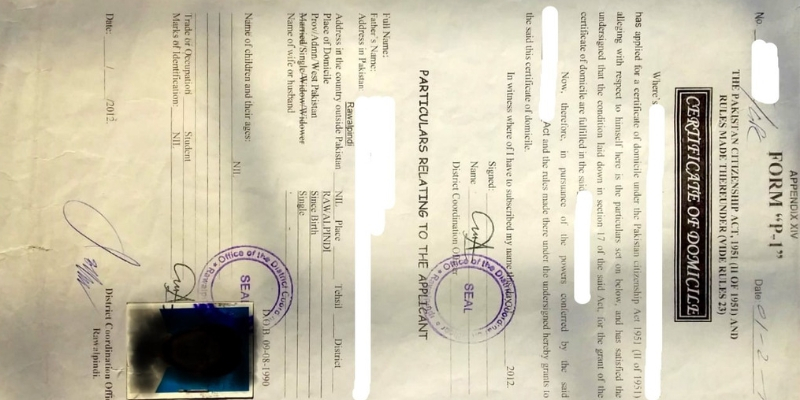The Securities and Exchange Commission of Pakistan (SECP) has got its roots from the Erstwhile Corporate Law Authority (CLA) later was a department with Finance Ministry. The process of restructuring the CLA was initiated in 1997 under the Capital Market Development Plan of the Asian Development Bank (ADB).
A Securities and Exchange Commission of Pakistan Act (hereinafter SECP ACT 2017) was enacted by the Parliament and promulgated in December 1997. In pursuance of this Act, the SECP, having autonomous status, became operational on January 1, 1999[1].
Read Also: Critical Analyses of SECP Act 1997 and Concerned Issues
From the very day of the inception of these organizations the issue of accountability and independence of such arises and before going further it is pertinent to explain the SECP and after that independence of SECP.
Securities and Exchange Commission of Pakistan
(SECP) is the financial regulatory agency in Pakistan whose objective is to develop a modern and efficient corporate sector and a capital market based on sound regulatory principles, to encourage investment and foster economic growth and prosperity in Pakistan.[2]
The relevant provisions of Companies Ordinance relating to the constitution of CLA (ss.11 & 12 (3) to (7)) have been repealed by s.43 of this Act and all the powers and functions of CLA are now vesting in SECP.
Functions & Objectives Of Regulator In SECP Act 1997
Generally securities & exchange regulation provide 3 main objectives.one of them is the protection of investors who have invested and have received certain securities. This is the top priority of a regulator to regulate the market in such an efficient manner where investor’s protection is not compromised.
The Second main objective of the regulator is to ensure a fair, efficient & transparent market. This situation seems to be ideal but it is not as simple as a bed of roses. The main reason behind this is that high-ups & business tycoons often use their interference to crash the market as was done in the 2005 & 2006 Scam.
The third objective of securities regulation is to reduce systemic risk (wrongly taken as systematic risk). Although the regulator can’t avoid such type of risk, yet he has statutory duty to reduce the risk. Risk can’t be avoided because it is in the built-in market however better handling may reduce the systemic risk.
Read Also: Demutualization of Stock Exchanges- Position In Pakistan
Contemporary Concepts Regarding Independence And Accountability Of SECP
United Kingdom
This department has gone through the following phases:
- The Board of Trade 1621 – 1970
- The Department of Trade and Industry 1970 – 1974
- The Department of Trade 1974 – 1983
- The Department of Trade and Industry 1983 – onward.
Role of BoT in development of English Company Law, I would also like to mention the wordings of an official historian of BoT, Mr. Llewellyn Smith, who wrote:[3]
“Broadly speaking the part played by the Bot concerning the movement which has revolutionized the structure of the industry has been that of a vigilant onlooker rather than of a continuous supervisor.”
India
The Central Government constituted an independent Company Law Board (CLB) vide
Notification S.I. No. 364 dated the 31st May 1991. The Board is a quasi-judicial body, consisting of nine members, that exercise some judicial and quasi-judicial powers which were earlier being exercised by the High Courts or the Central Government.
The Board is not subject to the control of the Central Government and has the powers to regulate its procedure and act in its discretion.[4]
CLB also acquired the status of a quasi-judicial body[5]. However, there is a conflict of opinion regarding its judicial character. Mr. R Santhanam is of the view that CLB is not competent to start prosecution in case any party makes a false statement or declaration.
Rather, it can only direct that a complaint against the wrongdoer be filed in a court of competent jurisdiction. While Mr. M. M. Sheth, in a letter to Mr. Santhanam, opposed this view and developed his analogy to prove that CLB is a court to start prosecution and punish the parties making any false statements or declarations.
Dr. Avtar Singh is of the view that CLB is a court-proper for the execution of its orders passed under the provisions of this Act. Due to the independent status given to CLB, it is now in a better position to work in harmony with the corporate sector for the development and administration of company law.
United States of America
IN the USA, the prevailing institution for regulatory affairs of the corporate world is SEC (SECURITIES AND EXCHANGE COMMISSION) which got its roots from Federal Trade Commission 12 enacted Under the Securities Exchange Act of 1934
The SEC is an independent, nonpartisan, quasi-judicial regulatory agency with responsibility for administering the federal securities laws. The purpose of these laws is to protect investors in securities markets that operate fairly and to ensure that investors have access to disclosure of all material information concerning publicly traded securities. The Commission also regulates firms engaged in the purchase or sale of securities, people who provide investment advice, and investment companies.
The Commission enforces the following laws:
- Securities Act of 1933
- Securities Exchange Act of 1934
- Investment Company Act of 1940
- Investment Adviser Act of 1940
- Public Utility Holding Company Act of 1935
- Trust Indenture Act of 1939
The Commission also serves as an adviser to federal courts in corporate reorganization Proceedings under Chapter 11 of the Bankruptcy Reform Act of 1978. The Commission reports annually to Congress on the administration of the securities laws.
What needs to be understood from this comparative analysis is that I am unable to locate even a single article on the defunct CLA in law journals of repute. Nor the university law journals have given any academic importance to this institution.
While in India, UK, USA it is a common practice to write on CORPORATE LAW BODY, DTII and SEC respectively. The reason why these countries rarely pass through bad phases is the reason behind that there is proper research by students and follow-up of legislation to cater to the needs of a modern corporate environment.
ISSUE: Considering The Standard Principles Relating To Regulators Can It Be Safely Stated That SECP Established Under SECP Act 1997 Is An Independent And Accountable Commission???
A principle about the securities regulator is that it “should be operationally independent and accountable in the exercise of its functions and powers.”[6]
A recent study has shown that the Independence of SECP and its accountability is at stake. This fact is evident from the eye-opening report of the Board of Directors of ADB to its president whereby serious concerns have been pointed out in nexus to independence and accountability of SECP.
The case of Pakistan concerning independence & accountability of SECP is different. The prevailing situation is alarming for the government due to too much outflow of capital.
Some incidents have been discussed hereinafter which poses a serious round of questions on accountability & independence of SECP. Firstly: SECP has become a captured agency of government that has full control and is using its authority arbitrarily.
It is evident from the fact that The Act of 2007[7] has amended the Securities and Exchange Commission Act, 1997, making the finance minister or, in his absence, an adviser to the prime minister on finance, as the case may be, chairman of SECP policy board.
It is worth mentioning here that the Finance Ministry is already exercising its control and the amendment brought by Act of 2007 has fully curtailed the powers and limbs of SECP. It is no more independent institution.
Similarly, accountability and Independence of SECP can be evident from the following:
Be it the NICL scam, the failure of Innovative Investment Bank or the Stock Exchange Crashes of 2005 and 2006, no corporate fraud with the public can be accounted for without appreciating SECP’s regulatory negligence[8].
It is worth mentioning here that SECP has been deliberately made like a disabled child. The reason behind this is the promotion and gaining of illegal gains (like some mentioned above Para).
Since its inception, SECP remained dysfunctional and had not been even structured legally for instance section 5 of the SECP act, 1997, states that “the Commission shall consist of a such number of commissioners, including the chairman, appointed by the Federal Government as may be fixed by the Federal Government, but such number shall not be less than five and more than seven.”
The SECP headed by Muhammad Ali Ghulam Mohammad had at once only two commissioners including the chairman.
Similarly, the government tried to keep the Independence of SECP constitutionally dysfunctional by keeping vacancies vacant just to keep the sword of Damocles hanging over the chairman.
The extent of in seriousness is evident from the fact that commissioners have full financial & job security but such perks, packages, and security is not available to Chairman SECP.
If this factor is overlooked even then when Chairman takes charge of his statutory duty then so many barriers are erected in his way. One may appraise this fact in the light of Dr. Tariq Hassan’s replacement as chairman[9].
Similarly, legislation which has been drafted and is the basis of SECP is also posing serious illegalities and making such decisions of such institution as De’facto. For instance, it has been part of legislation[10] that no decision of SECP can be turned down merely on the ground that no. of members of the board are not fulfilled, but this has turned down by the Apex Court[11].
It is part of the Captured Scheme Because In A State Of Limbo SECP Can’t Impose Its Decisions.
Similarly, legislation had provided that there must be disclosure in case there is a conflict of interest but how effectively this clause is handled can be better judged from practical examples. For instance industry insider was made the chairman SECP. Who himself has not only financial gains but also a conflict of interest with other members of the board[12].
The officials of SECP who are performing vital duties have no job security even after confirmation. This situation of insecurity and uncertainty is embedded in the legislation[13]. One can say that it has been made limbo constitutionally.
The last victim of the captured scheme of SECP was the Law Division who was the source of last internal checks and balances of SECP but due to illegal gains, this department has been paralyzed. Services of the officials of this department have been terminated in the past arbitrarily and on baseless grounds. This trend is also posing the serious question because Apex Courts have turned down presumptions where discretion has been applied arbitrarily[14].
Conclusion
In the end, I will quote William O. Douglas (Chairman, US SEC 1937-39) that “we are the Investor’s advocate”[15].
The central point will always remain that the companies flourish in a manner whereby the objective for which those are incorporated is healthily achieved. The basic philosophy of this control was “directed towards cleaning the existing malpractices in the corporate sector,” and to “increase the attractiveness and efficiency of the corporate form of organization.”[16]
It is my recommendation that academic studies in our institutions need to be more practical. There must be research in this sector that not only highlights the Pros & Cons of this institution but also give practical solutions to cater to the accountability and Independence of SECP.
BIBLIOGRAPHY
From Excessive Control to Effective Regulation by Muhammad Amir Munir.
SECP has now become a captured agency by Babar Sattar Saturday, June 25, 2011
Smith, Llewellyn., The Board of Trade, The Whitehall Series, 1928.
Corporate governance and accountability: Reform SECP By muhammad rabnawaz awan
LEGISLATION
SECP Act 1997
Finance Act, 2003
Securities Exchange Act of 1934
CASES AND REPORTS
Sindh high court bar association case (pld 2009 sc 879)
National bank of pakistan case (cp no 58 of 2010)
2011 plc (c.s.) 419 & ica 281/2010
Asian development bank’s report.
Pirzada Commission Report of 1961
[1] SECP Web Site. “Establishment of the Securities and Exchange Commission of Pakistan”. SECP. Retrieved 13 April 2010
[2] https://www.secp.gov.pk/about_secp.asp
[3] Smith, Llewellyn., The Board of Trade, The Whitehall Series, 1928, p. 168.
[4] < https://www.allindia.com/gov/ministry/finance/dca/law.htm
[5] This contention was raised as the provisions of sub-sections (4-C) and (4-D) of section 10-E of the Companies Act, 1956 provides that “every Bench shall be deemed to be a Civil Court for the purpose of s.195 and Chapter XXVI of the Code of Criminal Procedure 1973 and every proceedings before the Bench shall be deemed to be a judicial proceeding…
[6] Principle Taken from International Organization of Securities Commissions (IOSCO) website.
[7] Finance Act 2007
[8] Babar Sattar’s column in THE NEWS. Saturday, June 25, 2011
[9] Dr Hassan had been removed for “failing to control the situation and for his involvement in corruption”. Dr Hassan said that he had been removed because he had tried “to catch the big fish enjoying direct access to the prime minister”.
[10] Sec5(5) of SECP Act 1997, given power through Finance Act, 2003
[11] Sindh High Court Bar Association case (PLD 2009 SC 879) and the National Bank of Pakistan case (CP No 58 of 2010) held that such changes introduced through the Finance Act are unconstitutional.
[12] Muhammad Ali director of Fortune securities Ltd (subsequently made chairman SECP).
[13] Ss-5&8 of SECP ACT 1997
[14] 2011 PLC (C.S.) 419 & ICA 281/2010 where arbitrary use of power was termed as “recipe for corruption, mismanagement, nepotism and jobbery.”
[15] Reference can been located on US-SEC website.
[16] Pirzada Commission Report, Para 12.







